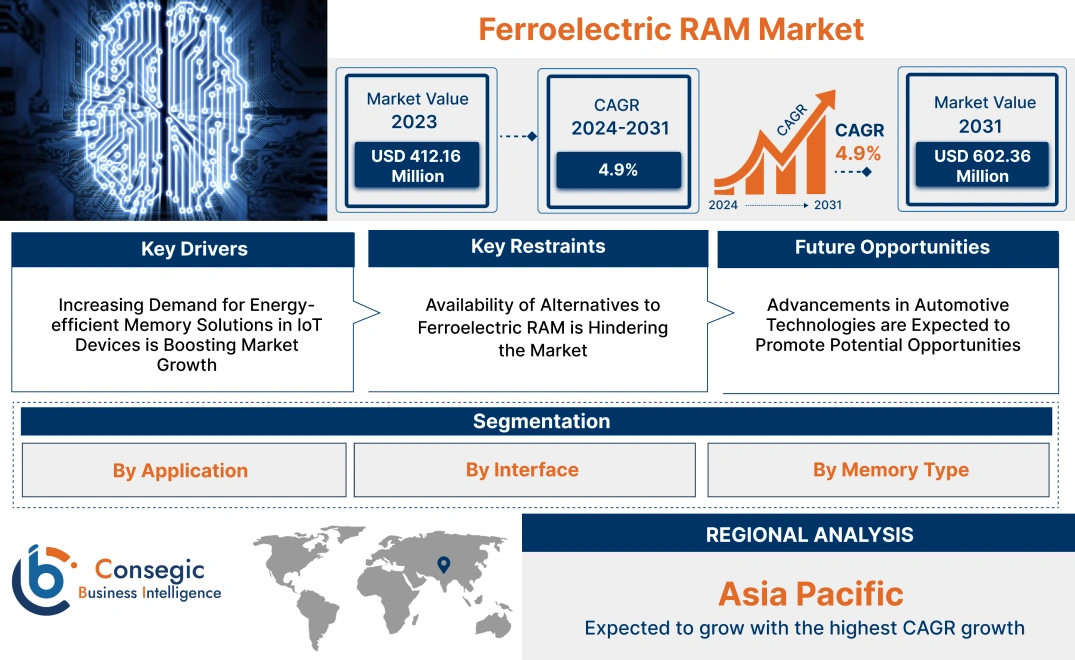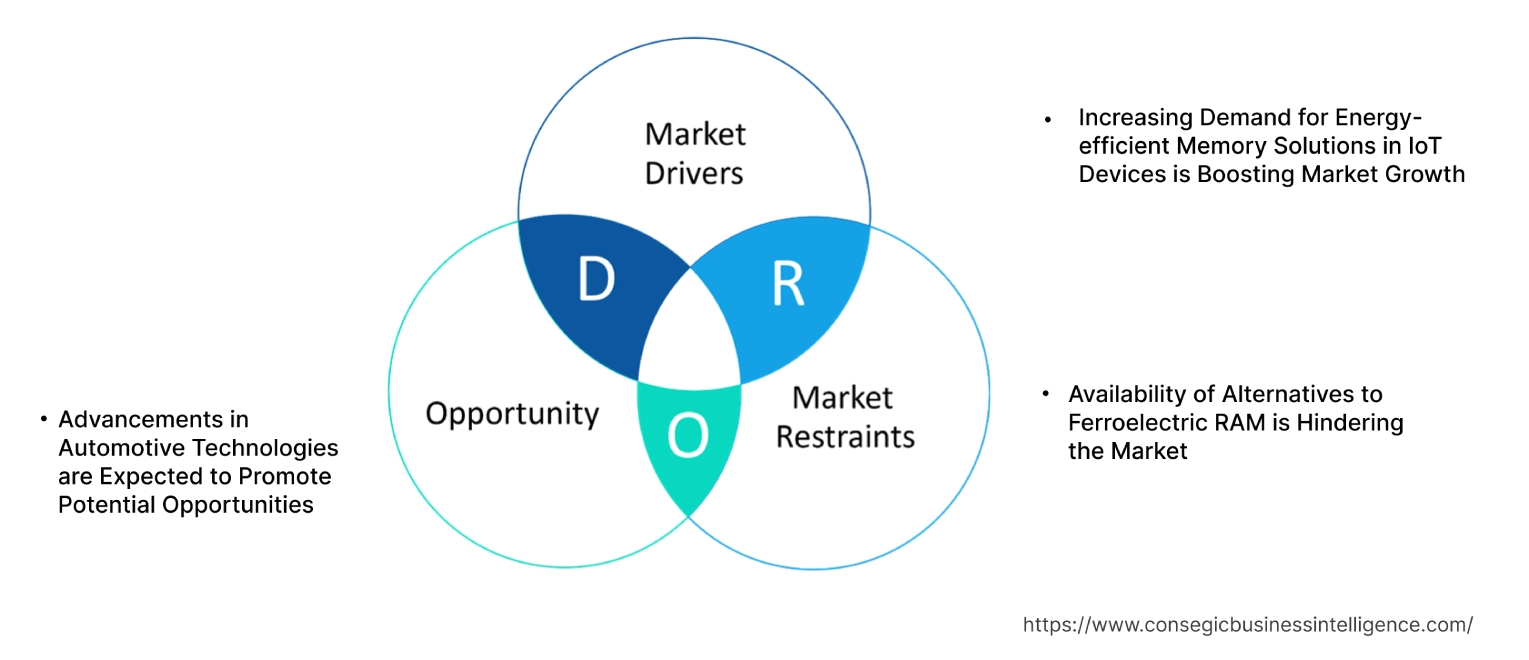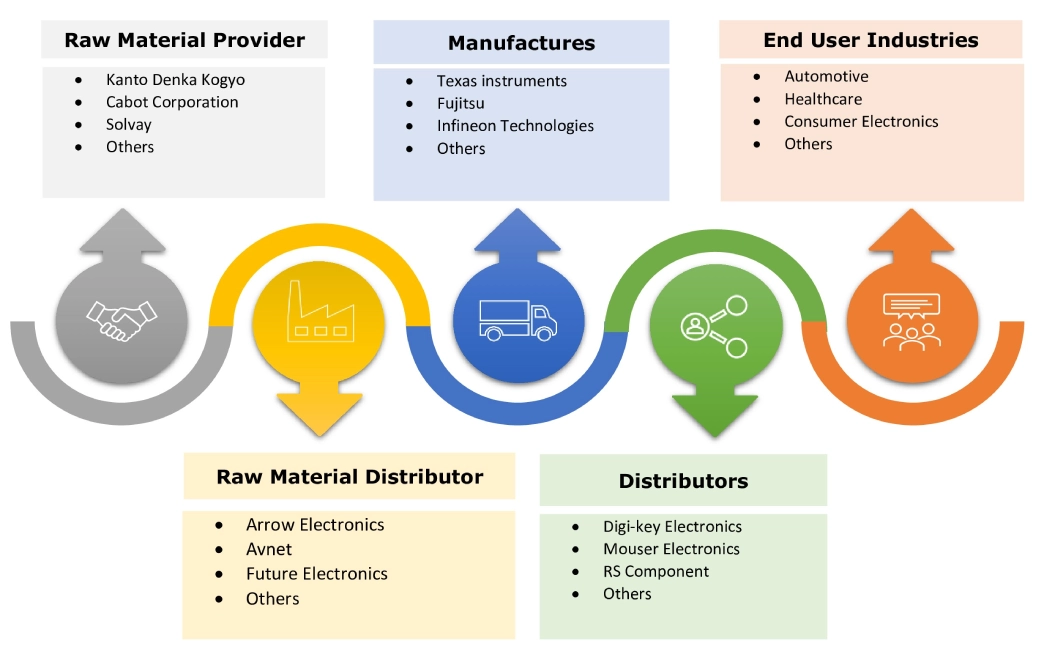- Summary
- Table Of Content
- Methodology
Ferroelectric RAM Market Size:
Ferroelectric RAM Market size is estimated to reach over USD 602.36 Million by 2031 from a value of USD 412.16 Million in 2023 and is projected to grow by USD 424.84 Million in 2024, growing at a CAGR of 4.9% from 2024 to 2031.
Ferroelectric RAM Market Scope & Overview:
Ferroelectric RAM (FRAM) is a type of non-volatile memory that combines the speed of DRAM (Dynamic RAM) and the data retention ability of Flash memory. It uses a ferroelectric layer instead of traditional capacitors or transistors to store data. When an electric field is applied, the ferroelectric material changes its polarization, which represents binary data (0s and 1s). This polarized state remains even without power, making FRAM non-volatile. Additionally, it offers the perfect balance between performance, energy savings, and data retention and it excels in specific areas where frequent, reliable data storage is critical, especially in industries like automotive, healthcare, and telecommunications. Overall, the combination of speed, reliability, and energy efficiency makes it an increasingly attractive option for industries that require frequent data access and storage, all while maintaining power efficiency.
Ferroelectric RAM Market Insights:
Key Drivers:
Increasing Demand for Energy-efficient Memory Solutions in IoT Devices is Boosting Market Growth
The rapid progress of the Internet of Things (IoT) has been a game-changer for many industries, and it's also driving the increased demand for Ferroelectric RAM. IoT devices, ranging from smart wearables to industrial sensors, are designed to function with minimal power while still maintaining the ability to process and store data continuously. This makes energy efficiency one of the most critical factors in determining the right memory technology for such devices. Additionally, its ability to perform fast operations with minimal energy use is particularly valuable for IoT devices that need to remain operational for extended periods on small power sources like batteries or even energy-harvesting systems. Moreover, its non-volatile nature ensures that data remains intact, even if there is a sudden power loss. This makes it ideal for applications where data integrity is critical, including in medical devices, environmental sensors, or industrial equipment.
- In November 2021, Fujitsu launched 8Mbit FeRAM MB85R8M2TA with a parallel interface, which is well-suited for applications requiring frequent data updates, such as smart meters and wearable health devices. This provides low power consumption and high endurance, allowing for reliable data storage in challenging environments.
Therefore, the increasing need for energy-efficient memory solutions in IoT devices is proliferating the Ferroelectric RAM market growth.
Key Restraints :
Availability of Alternatives to Ferroelectric RAM is Hindering the Market
Established alternative memory technologies including Flash memory, EEPROM, MRAM, ReRAM, and DRAM are widely available and often come at lower costs, making them more attractive for many applications, particularly in cost-sensitive sectors such as consumer electronics and IoT. While it offers unique benefits, including faster data access and higher endurance, the competitiveness of these alternatives deters potential adopters. As manufacturers prioritize cost-effectiveness and existing supply chains, the availability of these alternatives limits the market penetration, slowing its overall development in the evolving landscape of memory technologies.
- For instance, Samsung and Micron Technology continue to innovate in NAND Flash memory, significantly lowering costs while increasing storage capacities. This advancement makes Flash the preferred choice for a wide range of consumer electronics, from smartphones to SSDs, which limits the demand in those markets.
Hence, as per the analysis, the availability of alternatives including Flash memory, EEPROM, DRAM, MRAM, and ReRAM are significantly hindering the Ferroelectric RAM market demand.
Future Opportunities :
Advancements in Automotive Technologies are Expected to Promote Potential Opportunities
The automotive industry is increasingly adopting advanced driver-assistance systems (ADAS) and electric vehicles, which require robust memory solutions. As vehicles become smarter, ADAS technologies such as lane-keeping assistance, adaptive cruise control, and automatic emergency braking rely heavily on real-time data processing. The non-volatile nature of FRAM ensures that critical data is preserved even in the event of a power loss, which is vital for maintaining safety features and functionality. Additionally, the shift towards electric vehicles presents unique challenges and opportunities for memory technologies. EVs incorporate complex battery management systems, energy management, and various control systems that monitor performance and safety.
- For instance, Texas Instruments introduced its MSP430FR5x microcontrollerswhich integrate FRAM for automotive applications. These microcontrollers are designed for low-power sensing and monitoring tasks, making them ideal for ADAS features like collision detection and lane-keeping assistance.
Overall, the advancements in automotive technologies create strong Ferroelectric RAM market opportunities, driven by the need for memory solutions that can keep pace with the growing complexity and functionality of modern vehicles.
Ferroelectric RAM Market Segmental Analysis :
By Memory Type:
Based on memory type, the market is segmented into 4Kbit, 16Kbit, 64Kbit, 256Kbit, 521Kbit, and others.
Trends in the Memory Type:
- There is a growing trend of 5G and next-gen communication networks driving the need for 1Mbit FRAM, which supports larger data storage needs and faster access times in network equipment.
- Large Ferroelectric RAM capacities are being integrated into complex industrial control systems, where continuous data collection and analysis are vital for optimizing operations and reducing downtime.
The 64Kbit memory type accounted for the largest revenue share of the overall Ferroelectric RAM market share in 2023.
- The 64Kbit Ferroelectric RAM capacity provides enough storage without requiring excess power, making it an optimal choice for industries prioritizing sustainability.
- The high-speed data access capabilities are essential for real-time processing in dynamic environments including vehicle systems and industrial control processes.
- Additionally, this ferroelectric RAM strikes the perfect balance between capacity and cost, making it the preferred choice for durable, reliable, and affordable memory solutions.
- For instance, Infineon introduced FM25CL64B-G, a reliable 64kbit serial peripheral interface Fe-RAM with 20MHz frequency. Its high-speed data writing capability and resilience under heavy usage make it ideal for real-time applications including electric vehicle drivetrain systems and industrial automation.
- Thus, these advantages position 64Kbit Fe-RAM as a leading choice in sectors that need robust memory performance, which is fueling the Ferroelectric RAM market growth.
The 256Kbit is anticipated to register the fastest CAGR during the forecast period.
- The 256Kbit FRAM's ability to handle high write cycles and maintain data integrity in real-time processing environments makes it ideal for mission-critical applications, ensuring its relevance in future technology developments.
- The ability to handle high write cycles and maintain data integrity in real-time processing environments makes it ideal for mission-critical applications, ensuring its relevance in future technology developments.
- For instance, , Fujitsu Semiconductor offers the MB85RS256 256Kbit FRAM, which is being adopted in smart grid technologies for energy management systems. Its durability and low power consumption make it ideal for applications requiring continuous data logging.
- Therefore, as per the analysis versatility and performance characteristics of 256Kbit Fe-RAM is anticipated to boost the Ferroelectric RAM market trends.
By Interface:
Based on interface, the market is segmented into serial interface and parallel interface.
Trends in the Interface:
- The parallel interface is used in telecommunications and data-intensive applications, where high data throughput is necessary for efficient operation and performance.
- The growing shift towards connecting multiple devices on a single bus is driving the adoption of I²C interfaces, particularly in consumer electronics and smart home devices, where space and complexity need to be minimized.
The serial interface accounted for the largest revenue share in the year 2023 and is anticipated to register the fastest CAGR during the forecast period.
- Serial peripheral interface is favored for high-speed data transfer capabilities, making it suitable for applications that require rapid read and write operations.
- The straightforward design of the SPI interface allows for easier implementation in embedded systems. This simplicity makes it a popular choice among developers and engineers.
- It offers faster data rates allowing for quick communication between microcontrollers and memory.
- In January 2022, Fujitsu Semiconductor launched 8Mbit FeRAM MB85RQ8MLX with Quad SPI interface. It is nonvolatile memory ideal for industrial high-performance computing including programmable logic controllers (PLCs), human-machine interface (HMI), and RAID controllers.
- Overall, the combination of speed, efficiency, and ease of use makes SPI the leading interface in the Ferroelectric RAM market opportunities.
By Application:
Based on application, the market is segmented into automotive, healthcare, telecommunication, factory automation, and others.
Trends in the Application:
- The surging drift towards wearable technology and smart home devices is propelling the adoption of Fe-RAM, as these applications require energy-efficient memory for continuous data logging and updates.
- The trend towards IoT in healthcare is leading to the incorporation of Fe-RAM in smart medical devices, enabling real-time data analysis and remote diagnostics.
The automotive application accounted for the largest revenue share of 37.29% of the total Ferroelectric RAM market share in 2023.
- The automotive sector is rapidly integrating ADAS technologies, which require reliable and high-speed data storage solutions.
- The rise of electric vehicles (EVs) is driving demand for robust memory solutions in battery management systems and other automotive applications, where Fe-RAM's performance is critical for safety and efficiency.
- In December 2021, Infineon introduced FM24CL64B-G, a high-density 64kBit I2C Fe-RAM memory module designed to cater to the needs of automotive industries. It features high-endurance 10 trillion read/writes with no delay, advanced high-reliability ferroelectric process, fast 2-wire Serial interface, and low power consumption.
- Hence, the automotive industry's focus on safety, efficiency, and connectivity is propelling the Ferroelectric RAM market demand.
Healthcare is anticipated to register the fastest CAGR during the forecast period.
- The rise of telemedicine and remote patient monitoring systems is driving the need for secure and reliable data storage solutions.
- FRAM's low power consumption and durability make it ideal for medical devices that require constant data retention.
- Additionally, with growing concerns about patient data security, healthcare applications are prioritizing non-volatile memory solutions like Fe-RAM. Its ability to maintain data integrity even during power loss is crucial for sensitive medical information.
- Moreover, the trend towards IoT in healthcare is creating opportunities for Fe-RAM in smart medical devices. As more devices become connected, the need for efficient and reliable memory solutions will grow.
- Hence, according to the analysis, as healthcare segment is anticipated to boost the Ferroelectric RAM market trends during the forecast period.
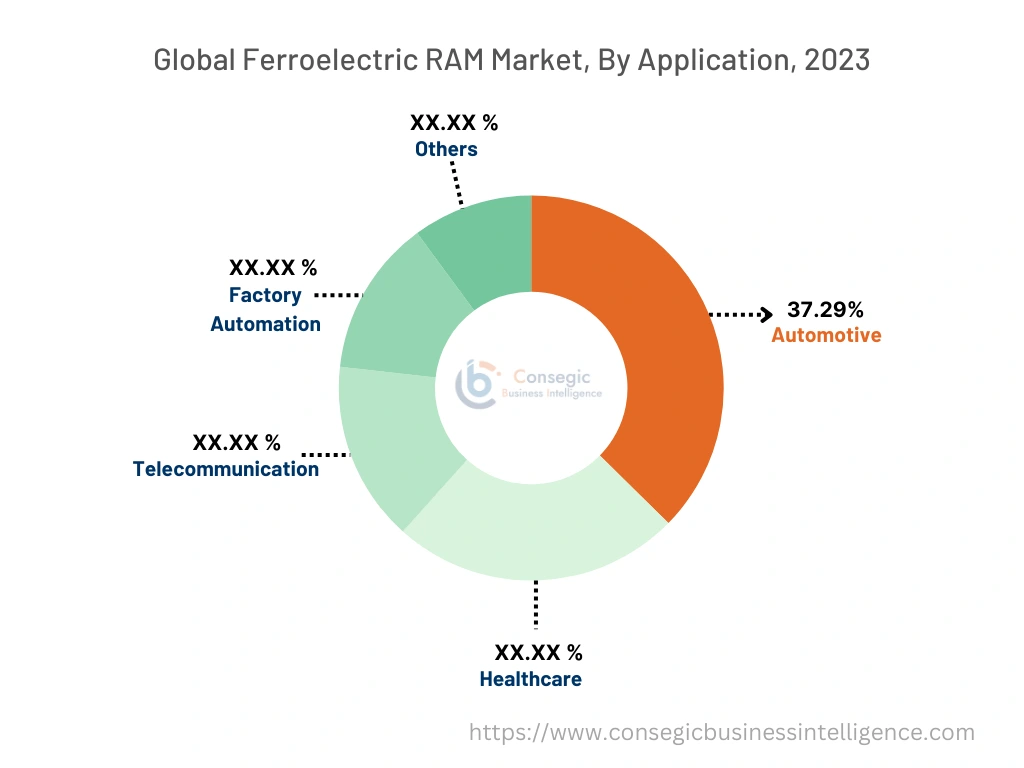
Regional Analysis:
The regions covered are North America, Europe, Asia Pacific, the Middle East and Africa, and Latin America.
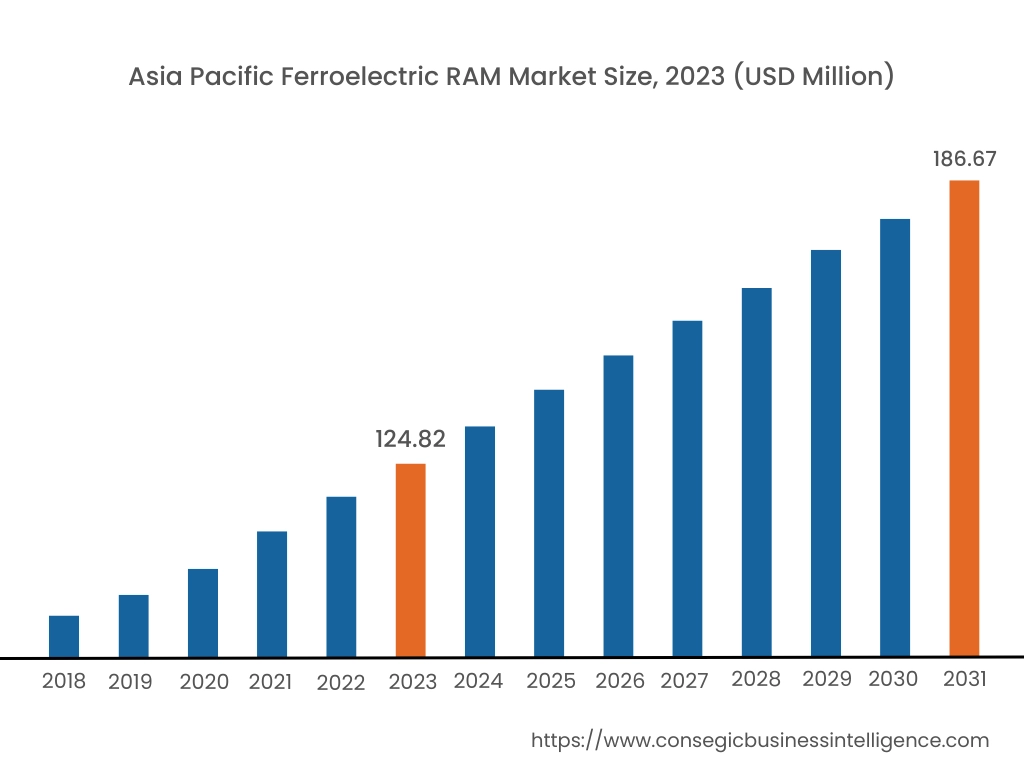
Asia Pacific region was valued at USD 124.82 Million in 2023. Moreover, it is projected to grow by USD 128.91 Million in 2024 and reach over USD 186.67 Million by 2031. Out of this, China accounted for the maximum revenue share of 31.7%. As per the Ferroelectric RAM market analysis, the Asia-Pacific region is expected to dominate the market. Countries including Japan, China, and South Korea have robust electronics manufacturing sectors, which are critical for the production and adoption of Fe-RAM technology in various applications including automotive, healthcare, and consumer electronics. Additionally, the increasing shift towards electric vehicles in Asia-Pacific is driving the need for reliable memory solutions, particularly in battery management systems and advanced driver-assistance systems (ADAS), where FRAM's performance is crucial.
- In August 2023, Fujitsu (Japan) launched MB85RC512LY, an I2C-interface 512Kbit Fe-RAM with 125oC operation. It is a non-volatile memory optimal for industrial robots and automotive applications such as Advanced Driver-Assistance Systems (ADAS) in automobile and industrial machinery that require high reliability in high-temperature environments.
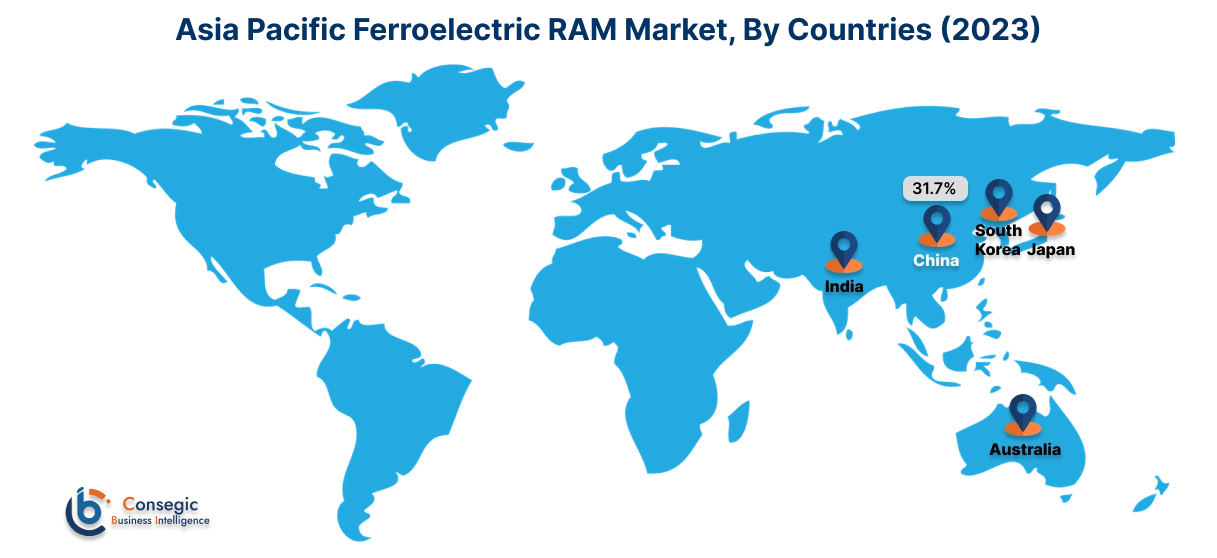
North America is estimated to reach over USD 219.86 Million by 2031 from a value of USD 149.04 Million in 2023 and is projected to grow by USD 153.75 Million in 2024. North America, particularly the United States, is currently a leading region in the market. The presence of major automotive manufacturers and suppliers in the region drives significant demand for FRAM, particularly in applications like advanced driver-assistance systems (ADAS) and electric vehicles (EVs). Additionally, the region is a hub for technology development, with numerous firms focusing on R&D in semiconductor technology, including FRAM solutions. This fosters a competitive environment that encourages the adoption of advanced memory technologies.
Europe is experiencing steady growth in the market, driven by stringent regulations regarding automotive safety and data security in healthcare. The region's focus on sustainable technology and the development of smart cities is enhancing the requirement for reliable memory solutions in various applications, including energy management and industrial automation.
While still emerging, the Ferroelectric RAM market expansion in Latin America is gradually pacing. Increased investments in technology infrastructure and the growth in adoption of smart devices are expected to drive the need for Fe-RAM solutions, particularly in the consumer electronics and automotive sectors.
The market in the Middle East and Africa is in its nascent stages but shows potential for growth. Initiatives to enhance healthcare infrastructure and the rising interest in smart city projects may create opportunities for Fe-RAM technology in various applications, particularly in healthcare and industrial automation.
Top Key Players & Market Share Insights:
The Ferroelectric RAM market is highly competitive with major players providing energy-efficient memory solutions to the national and international markets. Key players are adopting several strategies in research and development (R&D), product innovation, and end-user launches to hold a strong position in the global Ferroelectric RAM market. Key players in the Ferroelectric RAM industry include-
- Texas Instruments (USA)
- Cypress Semiconductor Corp (Infineon) (US)
- Toshiba Electronics (Japan)
- STMicroelectronics (Switzerland)
- Rohm Semiconductor (Japan)
- Panasonic (Japan)
- Kioxia (Japan)
- ON Semiconductor (USA)
- Fujitsu Semiconductor (Japan)
- Everspin Technologies (USA)
- Renesas Electronics (Japan)
- Microchip Technology (USA)
- NXP Semiconductors (Netherlands)
- Maxim Integrated (USA)
- ON Semiconductor (USA)
Recent Industry Developments :
Product Launches:
- In August 2023, Infineon launched two ferroelectric RAM devices in 1Mb and 4Mb densities to the EXCELON FRAM family. The devices are AEC-Q100 Grade 1 qualified and they support an extended temperature range (-40°C to 125°C). These devices feature fast and highly reliable read/write performance at speeds up to 50MHz in SPI mode and up to 108MHz in Quad SPI (QSPI) mode.
- In August 2023, Fujitsu (Japan) launched MB85RC512LY, an I2C-interface 512Kbit Fe-RAM with 125oC operation. It is a non-volatile memory optimal for industrial robots and automotive applications such as Advanced Driver-Assistance Systems (ADAS) in automobile and industrial machinery that require high reliability in high-temperature environments.
Announcement:
- In July 2023, Microchip Technology announced a USD 300 million as a multi-year initiative. The investment focused on enhancing engineering labs, serving the technical and business support requirements of a large and growing set of customers. This enhancement will eventually show the potential growth for Fe-RAM manufacturing.
Ferroelectric RAM Market Report Insights :
| Report Attributes | Report Details |
| Study Timeline | 2018-2031 |
| Market Size in 2031 | USD 602.36 Million |
| CAGR (2024-2031) | 4.9% |
| By Memory Type |
|
| By Interface |
|
| By Application |
|
| By Sales Channel |
|
| By End-User |
|
| By Region |
|
| Key Players |
|
| North America | U.S. Canada Mexico |
| Europe | U.K. Germany France Spain Italy Russia Benelux Rest of Europe |
| APAC | China South Korea Japan India Australia ASEAN Rest of Asia-Pacific |
| Middle East and Africa | GCC Turkey South Africa Rest of MEA |
| LATAM | Brazil Argentina Chile Rest of LATAM |
| Report Coverage |
|
Key Questions Answered in the Report
What is FRAM? +
Ferroelectric RAM (FRAM) is a type of non-volatile memory that combines the speed of DRAM (Dynamic RAM) and the data retention ability of Flash memory. It uses a ferroelectric layer instead of traditional capacitors or transistors to store data.
How big is the Ferroelectric RAM Market? +
Ferroelectric RAM Market size is estimated to reach over USD 602.36 Million by 2031 from a value of USD 412.16 Million in 2023 and is projected to grow by USD 424.84 Million in 2024, growing at a CAGR of 4.9% from 2024 to 2031.
What is the key market trend? +
The trend towards IoT in healthcare is leading to the incorporation of Fe-RAM in smart medical devices, enabling real-time data analysis and remote diagnostics.
Who are the major key players in the Ferroelectric RAM Market? +
The key players in the Ferroelectric RAM Market are Texas Instruments (USA), Cypress Semiconductor Corp (Infineon) (US), Fujitsu Semiconductor (Japan), Toshiba Electronics (Japan), STMicroelectronics (Switzerland), Rohm Semiconductor (Japan), Panasonic (Japan), Everspin Technologies (USA), Renesas Electronics (Japan), Microchip Technology (USA), NXP Semiconductors (Netherlands), Maxim Integrated (USA), Kioxia (Japan), ON Semiconductor (USA), Analog Devices (USA), and others.
